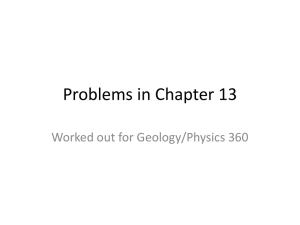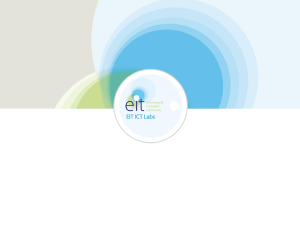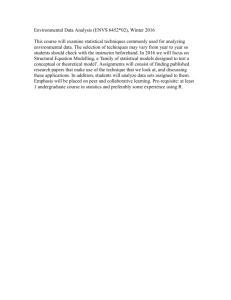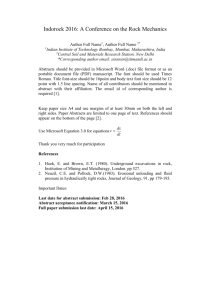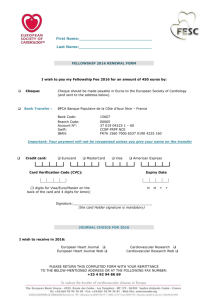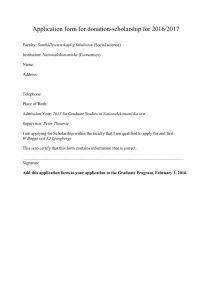PPARC forms - Institute of Cosmology and Gravitation
advertisement
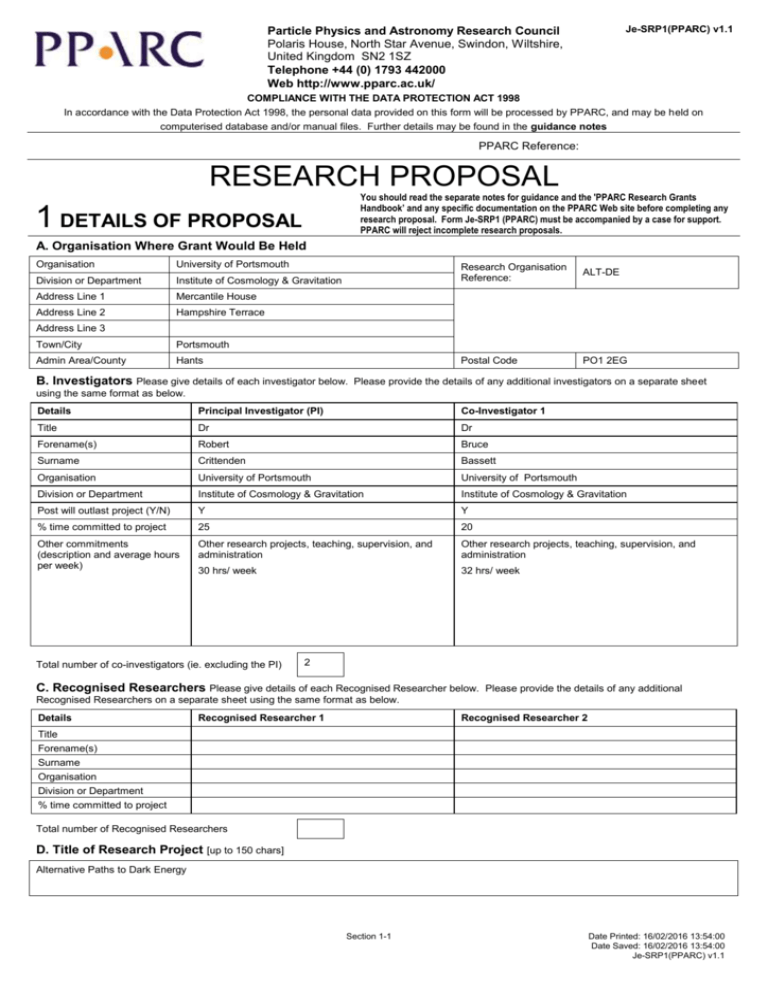
Je-SRP1(PPARC) v1.1 Particle Physics and Astronomy Research Council Polaris House, North Star Avenue, Swindon, Wiltshire, United Kingdom SN2 1SZ Telephone +44 (0) 1793 442000 Web http://www.pparc.ac.uk/ COMPLIANCE WITH THE DATA PROTECTION ACT 1998 In accordance with the Data Protection Act 1998, the personal data provided on this form will be processed by PPARC, and may be held on computerised database and/or manual files. Further details may be found in the guidance notes PPARC Reference: RESEARCH PROPOSAL You should read the separate notes for guidance and the 'PPARC Research Grants Handbook’ and any specific documentation on the PPARC Web site before completing any research proposal. Form Je-SRP1 (PPARC) must be accompanied by a case for support. PPARC will reject incomplete research proposals. 1 DETAILS OF PROPOSAL A. Organisation Where Grant Would Be Held Organisation University of Portsmouth Division or Department Institute of Cosmology & Gravitation Address Line 1 Mercantile House Address Line 2 Hampshire Terrace Research Organisation Reference: ALT-DE Postal Code PO1 2EG Address Line 3 Town/City Portsmouth Admin Area/County Hants B. Investigators Please give details of each investigator below. Please provide the details of any additional investigators on a separate sheet using the same format as below. Details Principal Investigator (PI) Co-Investigator 1 Title Dr Dr Forename(s) Robert Bruce Surname Crittenden Bassett Organisation University of Portsmouth University of Portsmouth Division or Department Institute of Cosmology & Gravitation Institute of Cosmology & Gravitation Post will outlast project (Y/N) Y Y % time committed to project 25 20 Other commitments (description and average hours per week) Other research projects, teaching, supervision, and administration Other research projects, teaching, supervision, and administration 30 hrs/ week 32 hrs/ week Total number of co-investigators (ie. excluding the PI) 2 C. Recognised Researchers Please give details of each Recognised Researcher below. Please provide the details of any additional Recognised Researchers on a separate sheet using the same format as below. Details Recognised Researcher 1 Recognised Researcher 2 Title Forename(s) Surname Organisation Division or Department % time committed to project Total number of Recognised Researchers D. Title of Research Project [up to 150 chars] Alternative Paths to Dark Energy Section 1-1 Date Printed: 16/02/2016 13:54:00 Date Saved: 16/02/2016 13:54:00 Je-SRP1(PPARC) v1.1 Other Investigators Please give details of each investigator below. Please provide the details of any additional investigators on a separate sheet using the same format as below. Details Co-Investigator 2 Co-Investigator 3 Title Dr Forename(s) Robert Surname Nichol Organisation University of Portsmouth Division or Department Institute of Cosmology & Gravitation Post will outlast project (Y/N) Y % time committed to project 25 Other commitments (description and average hours per week) Other research projects, supervision, development of masters program and administration 30 hrs/ week Total number of co-investigators (ie. excluding the PI) 2 Section 1-2 Date Printed: 16/02/2016 13:54:00 Date Saved: 16/02/2016 13:54:00 Je-SRP1(PPARC) v1.1 E. Start Date and Duration a. Proposed start date 01/10/05 b. Duration of the grant (months) 36 F. Type of Proposal Scheme: Astronomy research grants Type: Standard G. Summary of PPARC Resources Required for Project a. Financial resources required b. Summary of staff effort requested Total £ Staff 101042 Months Research 36 Travel and Subsistence 7,500 Technician Consumables 2,850 Other 8% x 36 Total 42.5 Exceptional Items Equipment 10% x 36 7,500 Large Capital Sub-total 118892 Indirect Costs Total 46479 165371 H. Related Proposals PPARC Reference Number How related? (one of Continuation, Follow-up to outline proposal, Invited resubmission, Uninvited resubmission) Total Number of Proposals being submitted Name of Lead RO a. If this proposal is related to a previous proposal to PPARC, please give the previous PPARC research grant proposal reference number(s) and indicate the type of relationship. Common Reference b. If there is more than one organisation submitting a Je-SRP1 (PPARC) proposal form for this project, please give the number of proposals involved, the lead Research Organisation and the project common reference. I. Research Councils / MoD Joint Research Grants Scheme (JGS) If you have received a commitment of support from the Defence Science Technology Laboratory (DSTL), please give the following details: Percentage funding indicated by DSTL DSTL contact (name and address) Title/Forename(s) Surname Address Line 1 Address Line 2 Address Line 3 Town/City Administrative Area/County Postal Code Telephone Fax E-mail DSTL Reference (please ensure that the letter providing this reference is attached with the Case for Support) Section 1-3 Date Printed: 16/02/2016 13:54:00 Date Saved: 16/02/2016 13:54:00 Je-SRP1(PPARC) v1.1 J. Objectives List main objectives of the proposed research in order of priority [up to 4000 chars] Dark Energy is one of the biggest unsolved puzzles in the whole of science today. The primary objective of this grant is to obtain new constraints on the nature of this dark energy using CMB-large scale structure observations and the ages of massive elliptical galaxies at high redshift . Our specific objectives are: Calculating new predictions for the CMB-large scale structure correlations from the integrated Sachs-Wolfe (ISW) effect, and its dependence on the equation of state and speed of sound of the dark energy. In addition, we will determine the theoretical limits to these ISW constraints and make new predictions for future ISW experiments. Combine an array of present detections of the ISW effect to further constrain dark energy models. In addition, use new data from the Sloan Digital Sky Survey (SDSS) and SDSS-2dF LRG survey to obtain one of the best recent measurements of dark energy. Use new observations of a large number of massive elliptical galaxies at high redshift (SDSS and SDSS-2dF) to measure the evolution of the Hubble parameter and thereby obtain one of the first constraints of the equation of state of dark energy. Combining these constraints with more traditional probes of dark energy (SN, CMB) to distinguish between various theoretical dark energy and modified gravity models. K. Summary Describe the proposed research in a style that would be accessible to an interested 14 year old [up to 4000 chars] It has long been understood that the Universe we live in is expanding as the consequence of an initial `big bang” 13.8 billion years ago. Cosmologists had always assumed that this expansion was driven by ordinary matter (like you and me), which meant that the rate of expansion should be slowing down. However, in 1998, researchers found that by observing the brightness of very distant exploding stars, the expansion of the Universe actually appears to be accelerating not slowing down! This was a shock and has raised the question “What mysterious force driving this acceleration?” In 2003, it became clear that cosmologists needed some new kind of matter, much different than anything we have seen before, to dominate the Universe and beat the effect of gravity on the largest scales in the Universe. The existence of this new kind of matter, known as `dark energy’ because we have not been able to observe it directly, was hailed as the ``Breakthrough of the Year’’ by Science magazine in 2003. Given that this dark energy appears to be the most abundant component of our Universe, we are very interested to learn as much as we can about it. For example, how is it distributed in the Universe? Is there the same amount everywhere, or does it cluster into lumps like ordinary matter? Also, how does it evolve with time? Has it always dominated the Universe, or was there a time when it was less important? Finally, does it really exist, or is what we see just evidence that we do not understand how Einstein’s laws of gravity on very large distances? Unfortunately, dark energy is difficult to learn about. Precisely because it is `dark’, we cannot observe it directly and we have not found any evidence of it interacting with ordinary matter. Thus far we have only been able to see how it influences the expansion of the Universe gravitationally. All the evidence we have for it is fairly indirect, so we have learnt relatively little about it so far. The aim of this proposal is to try to look at dark energy differently from the ways its been observed before. One method will be to try to understand how the age of the Universe changed as it expanded, because this will show how fast the expansion occurred. To do this, we will use new data from new surveys of galaxies at high `redshift’, i.e. galaxies so far away from us that the light we see was emitted when the Universe was much younger. By looking at the light from these galaxies, we will try to determine how old the galaxies are. If we look at enough galaxies, the oldest ones we see should be nearly as old as the Universe itself was when the light was emitted. In this way, we will be able to follow how fast the expansion was, and whether the dark energy was important early in the history of the Universe. It’s analogus to looking for the oldest fossil on Earth to determine the age of our planet. Another way we plan on studying the dark energy is by looking at the heat , or light, left over from the initial big bang, known as the cosmic microwave background (CMB). This light has passed unperturbed since it was first emitted. It does interact gravitationally with large lumps of matter in the Universe, but usually the energy it gains falling into the gravitational field of the matter is lost when the light moves out of the influence of the matter. However, if dark energy is around, then suddenly this is no longer true. The light actually gains energy by having passed through the matter. Thus we can show the presence of dark energy if we see that the energy of the CMB light corresponds with the distribution of matter in the universe. This correspondence between the energy of the light and the matter in the Universe has actually been seen. This was first reported by investigators of this proposal, and gave important confirmation of the existence of dark energy. There is still much more to learn from this however, as it is not yet clear precisely when these correlations arose. We plan to investigate this, combining various existing surveys of the distribution of matter, and with data that is just coming in from the Sloan Digital Sky Survey. We also plan on looking for signs of clustering in the dark energy, since it should also interact gravitationally with the CMB. Finally, we will combine both of these new windows into the nature of dark energy with the more traditional approaches, in order to get a fuller picture of this mysterious substance that dominates our Universe. Section 1-4 Date Printed: 16/02/2016 13:54:00 Date Saved: 16/02/2016 13:54:00 Je-SRP1(PPARC) v1.1 L. Beneficiaries Describe who will benefit from the research [up to 4000 chars] The most immediate benefit will be to cosmologists aiming to understand how the Universe has evolved and why its expansion is accelerating. The results will also be of great interest to particle physicists struggling to understand the fundamental constituents of the Universe, in particular whether they will have to explain such a small value of a cosmological constant, or whether some kind of light scalar field dominates the Universe. In either case the implications for particle physics models could be dramatic and probe in physics beyond the standard model. Furthermore, our research will be of great interest to Relativitists and studies of Einsteins general theory of relativity, as it will potentially promote new theories of gravity on the largest scales in the Universe. In summary, the study of dark energy has profound consequences across the whole of physics and is one of the biggest puzzles in the whole of science. The computational algorithms we are developing as part of this research (eg fast cross-correlation codes run on large supercomputers) will be published via AstroGrid (AG) and the Virtual Observatory (VO), and therefore be of great benefit to other astronomers around the world. Bob Nichol is a senior member of the VO and AG. These algorithms will also be of benefit to other sciences like biology and geology , and we will work towards publishing them to as broad a community as possible Finally, as has been demonstrated by dark energy being named Science magazine’s ‘Breakthrough of the Year’ in 2003, the public clearly has a very strong interest in cosmology and in particular in this strange matter which dominates the Universe. For example, Bob Nichol (co-I of this proposal) was recently a guest on the US “David Letterman Show” to discuss his work with the SDSS and ISW effect, and its consequences for understanding dark energy. We will continue our public outreach efforts during this grant by exposing both students and the public to our work and any new results. . Section 1-5 Date Printed: 16/02/2016 13:54:00 Date Saved: 16/02/2016 13:54:00 Je-SRP1(PPARC) v1.1 M. Staff Joint Negotiating Committee For Higher Education Staff (JNCHES – formerly UCEA) Posts EFFORT ON PROJECT Name /Post Identifier Grade Starting Spine Point Effective Date of Salary Scale Increment Date Start Date Period on Project (months) % of Full Time London Allowance (Y/N) Total of Other Allowances (over period of appointment) (£) Total cost on grant (£) i) Research Staff PDRA RA1A 8 01/08/04 1-Sep 01/10/05 36 100 % N 89273 % % % % % % % % % % % % ii) Technical Staff Secretary (Chris Duncan) SCP 15 31 01/08/04 1-Apr 01/10/05 36 8% N 4,860 Computer Manager SCP 19 39 01/08/04 1-Apr 01/10/05 /05 36 10 % N 6,909 % % % % % % % % % % % % Total 101042 [ Section 1-6 Date Printed: 16/02/2016 13:54:00 Date Saved: 16/02/2016 13:54:00 Je-SRP1(PPARC) v1.1 Non-JNCHES Posts EFFORT ON PROJECT Name / Post Identifier Basic Starting Salary Scale Effective Date of Salary Scale Increment Date Start Date Period on Project (months) % of Full Time London Allowance (£) Superannuation and NI (£) Total of Other Allowances (over period of appointment) (£) Total cost on grant (£) i) Research Staff % % % % % % % % % ii) Technical Staff % % % % % % % % % iii) Other Staff % % % % % % % % Total Section 1-7 Date Printed: 16/02/2016 13:54:00 Date Saved: 16/02/2016 13:54:00 Je-SRP1(PPARC) v1.1 Ma. Visiting Researchers Please provide the details of any additional visiting researchers on a separate sheet in the same format as below. Details Visiting Researcher 1 Visiting Researcher 2 Visiting Researcher 3 Title Forename(s) Surname Home Organisation Division or Department Address Line 1 Address Line 2 Address Line 3 Town/City Administrative Area/County Postal Code Country Telephone Fax E-mail Total number of visiting researchers N. Travel and Subsistence Destination and purpose Total £ (i) Within UK National collaborations and meetings (including UK Cosmology, RAS and NAM) 900 (ii) Outside UK International collaborations, workshops and conferences 4,500 Total £ Section 1-8 5,400 Date Printed: 16/02/2016 13:54:00 Date Saved: 16/02/2016 13:54:00 Je-SRP1(PPARC) v1.1 O. Consumables Description Total £ General consumables 2,100 Computer maintenance 750 Total £ 2,850 P. Exceptional Items Description Total £ Total £ Q. Equipment (single items between £3,000 and £49,999, including VAT) Description Country of Manufacture Delivery Date Linux workstation, UK October 2005 Basic price £ Import duty £ VAT £ Total £ 7500 peripherals & laptop Total £ 7500 VAT £ Total £ R. Large Capital (single items £50,000 and over, including VAT) Description Country of Manufacture Delivery Date Basic price £ Import duty £ Total £ Section 1-9 Date Printed: 16/02/2016 13:54:00 Date Saved: 16/02/2016 13:54:00 Je-SRP1(PPARC) v1.1 S. Facilities Please give details of any proposed usage of PPARC-funded facilities, completing a separate facilities form if necessary. Name of Facility Proposed Usage T. Other Support Give details of any support sought or received from any source for this or related research in the past three years. Decision Made (Y/N) Award Made (Y/N) Start Date End Date Amount Sought/ Awarded (£) Y Y Not yet known 2 years 80,000 Euros European Dark Energy Network (EDEN) Y N Visiting programme in relativistic astrophysics and cosmology Y Y Awarding Organisation Awarding Organisation’s Reference Title of project EU Marie Curie IRG Fast Algorithms in Cosmology and the study of Dark Energy (small overlap) EU 512251 Marie Curie RTN PPARC PPA/V/S/2001/0 0544 Nichol Re-integration grant Section 1-10 100K of 1.5M Euros 1/4/03 31/3/0 6 12,610 Date Printed: 16/02/2016 13:54:00 Date Saved: 16/02/2016 13:54:00 Je-SRP1(PPARC) v1.1 U. Project Partners Please give details of partners in the project and their contributions to the research. These contributions should be in addition to resources identified above. If there are more than two partner organisations, please provide details on a separate sheet using the same format as below. Details Name of partner organisation Partner 1 Partner 2 Division/Department Address Line 1 Address Line 2 Address Line 3 Town/City Administrative Area/County Postal Code Country Title/Forename(s) of Contact Surname of Contact Contact’s Address (if different from organisation address) Address Line 1 Address Line 2 Address Line 3 Town/City Administrative Area/County Postal Code Country Telephone Fax E-mail Direct contribution to project a. cash Description Value £ Description Value £ b. equipment/materials c. secondment of staff d. other Sub-Total Indirect contribution to project a. use of facilities/equipment b. staff time c. other Sub-Total Total Contribution Total Value (including contributions from additional project partners) Total number of project partners Section 1-11 Date Printed: 16/02/2016 13:54:00 Date Saved: 16/02/2016 13:54:00 Je-SRP1(PPARC) v1.1 1V. Classification of Grant Proposal Classify your proposal under each of the following four headings. (a) Peer Review Preference Tick one of the following boxes to indicate the PPARC peer review panel you consider most appropriate to assess this proposal. Astronomy Grants Panel: Astro Theory Sub Panel Astronomy Grants Panel: Astro Observation Sub Panel Astronomy Grants Panel: Solar System Sub Panel Astronomy Grants Panel (High Performance Computing) Space Missions/Ground Based Facilities Panel for the Allocation of Telescope Time Particle Astrophysics Particle Physics (Experiment) Particle Physics (Theory) Particle Physics (HPC) PPARC Industrial Programme Support Scheme (PIPSS) Faraday Partnership E-Science and the Grid Other (b) Scientific Areas Assign % relevance (in multiples of 5) to any areas that are relevant, totalling 100%. Scientific Area Broad Indication of Category Astrometry, celestial mechanics, databases and survey astronomy eg. Catalogues, star atlases, stellar dynamics % Solar and solar-terrestrial physics the Sun, ionospheric physics, magnetosphere, solar wind, solar terrestrial relations Planetary science planets and other Solar System bodies (other than the Sun) and extra-Solar System planetary systems Stars including pulsars, supernovae, nucleosynthesis, protostars and young stellar objects, star formation, brown dwarfs Galactic and inter-stellar astronomy eg. Galactic centre, star clusters, Galactic structure, formation and evolution of the Galaxy, kinematics and dynamics of the Galaxy, inter-stellar medium, molecular clouds, planetary nebulae, supernovae remnants, dust inter-stellar chemistry Extra-galactic astronomy and cosmology eg. Galaxy formation and evolution, active galactic nuclei, jets, quasars, large scale structure, clustering, early Universe, Hubble constant, cosmic microwave background, inflation 60 Physics and physical processes not specifically astronomy, planetary science or particle physics eg. Accretion, black hole physics, gravity, magnetic fields, atomic and molecular processes, relativity 15 Particle cosmology eg. Dark matter, supersymmetry, neutrinos, cosmic strings 25 Beyond the Standard Model eg. Origin of mass The Standard Model eg. Quarks, leptons, cp-violation, matter-antimatter asymmetry, QCD, electroweak interactions, supersymmetry (SUSY) Total = 100% (c) Types of Activity Assign % relevance (in multiples of 5) to the activities listed, totalling 100%. Type of Activity Operation & maintenance of facilities Broad Indication of Category The recurrent cost of providing facilities % Investment in new instrumentation, facilities or techniques Exploitation and experiment For example, design and construction of new facilities and instruments, instruments and technique development and research on underpinning technology Data collection, data analysis, experimental research Theory Theoretical research including modelling 50 50 Total = 100% (d) Facilities or Wavelengths If the programme is associated with a particular wavelength range, assign % relevance (in multiples of 5) to each relevant wavelength. If applicable, please also assign % relevance (in multiples of 5) to ground or space-based activities. For particle physics, please indicate the facility. The allocations need not sum to 100%. Facility/Wavelength % Wavelength (continued) % Ground or Space Gamma-ray Radio Ground-based X-ray LHC Space-based UV LEP Optical/IR 80 HERA mm/sub-mm 20 Other particle physics facilities Total <= 100% Section 1-12 % Total <= 100% Date Printed: 16/02/2016 13:54:00 Date Saved: 16/02/2016 13:54:00 Je-SRP1(PPARC) v1.1 Section 1-13 Date Printed: 16/02/2016 13:54:00 Date Saved: 16/02/2016 13:54:00 Je-SRP1(PPARC) v1.1 2 OTHER INFORMATION Information in this section will be used for administrative purposes including the selection of peer reviewers. A. Nominated Referees Please give details of a referee whom PPARC may approach for assessment of this research proposal. Details Referee 1 Title Forename(s) Surname Organisation Division or Department Address Line 1 Address Line 2 Address Line 3 Town/City Administrative Area Postal Code Country Telephone Fax E-mail Section 2-1 Date Printed: 16/02/2016 13:54:00 Date Saved: 16/02/2016 13:54:00 Je-SRP1(PPARC) v1.1 B. Declaration In submitting this research proposal, I confirm on behalf of the Administrative Authority of …………………………………………………………………….. [Name of Submitting Organisation] that: a. b. c. we have read and understood the requirements in the PPARC Research Grants Handbook and have checked that the proposal complies with these if a grant is offered we will accept the terms and conditions applied by PPARC we have not entered into any obligations which may conflict with the PPARC terms and conditions Name in BLOCK CAPITALS: Position: Signature: Date: Name in BLOCK CAPITALS Principal Investigator ROBERT CRITTENDEN Co-Investigators ROBERT NICHOL Signature Date BRUCE BASSETT Recognised Researchers Head of Department ROY MAARTENS Section 2-2 Date Printed: 16/02/2016 13:54:00 Date Saved: 16/02/2016 13:54:00 Je-SRP1(PPARC) v1.1 3. PERSONAL INFORMATION Information in this section will be used for administrative and statistical purposes and will NOT be circulated to referees or panels. B. Investigators Please give details of each investigator below. Please provide the details of any additional investigators on a separate sheet using the same format as below. Details Principal Investigator Co-Investigator 1 PID 44551 55432 Robert Crittenden Bruce Bassett Address Line 1 Institute of Cosmology and Gravitation Institute of Cosmology and Gravitation Address Line 2 University of Portsmouth University of Portsmouth Address Line 3 Mercantile House Mercantile House Town/City Portsmouth Portsmouth Administrative Area Hampshire Hampshire Telephone PO1 2EG 023 9284 5625 PO1 2EG 023 9284 5171 Fax 023 9284 5626 023 9284 5626 E-mail robert.crittenden@port.ac.uk bruce.bassett@port.ac.uk Date of Birth 23/04/66 23/09/71 Sex M M Ethnic Origin White American White South African Disability (Y/N, details of disability) N N Current Post Reader Reader Current Post Start Date 01/10/2002 01/07/2003 Sector HEI HEI Function Academic Academic Expertise (This information may be used to help identify expertise in a given area and to select potential referees). Theoretical cosmology; CMB anisotropies; large scale structure; origin of perturbations; dark energy Theoretical cosmology; origin and evolution of primordial perturbations; early universe, inflationary cosmology and preheating Suffix (eg FRS) Preferred form of name Address (if different from main department address) Postal Code Section 3-1 Date Printed: 16/02/2016 13:54:00 Date Saved: 16/02/2016 13:54:00 Je-SRP1(PPARC) v1.1 C. Recognised Researchers Please give details of each Recognised Researcher below. Please provide the details of any additional Recognised Researchers on a separate sheet using the same format as below. Details Recognised Researcher 1 Recognised Researcher 2 PID Suffix (eg FRS) Preferred form of name Address (if different from main department address) Address Line 1 Address Line 2 Address Line 3 Town/City Administrative Area Postal Code Telephone Fax E-mail Date of Birth Sex Ethnic Origin Disability (Y/N, details of disability) Current Post Current Post Start Date Sector Function Expertise (This information may be used to help identify expertise in a given area and to select potential referees). Section 3-2 Date Printed: 16/02/2016 13:54:00 Date Saved: 16/02/2016 13:54:00 Je-SRP1(PPARC) v1.1 PERSONAL INFORMATION Information in this section will be used for administrative and statistical purposes and will NOT be circulated to referees or panels. B. Investigators Please give details of each investigator below. Please provide the details of any additional investigators on a separate sheet using the same format as below. Details Co-Investigator 2 Co-Investigator 3 PID Suffix (eg FRS) Preferred form of name Address (if different from main department address) Robert Nichol Address Line 1 Institute of Cosmology and Gravitation Address Line 2 University of Portsmouth Address Line 3 Mercantile House Town/City Portsmouth Administrative Area Hampshire Postal Code Telephone PO1 2EG 023 9284 3117 Fax 023 9284 5626 E-mail bob.nichol@port.ac.uk Date of Birth 30/09/66 Sex M Ethnic Origin White British Disability (Y/N, details of disability) N Current Post Senior Lecturer Current Post Start Date 01/08/04 Sector HEI Function Academic Expertise (This information may be used to help identify expertise in a given area and to select potential referees). Observational cosmology; large scale structure surveys; galactic evolution; galaxy clusters; dark energy ; e-Science and Grid ; Statistics Section 3-3 Date Printed: 16/02/2016 13:54:00 Date Saved: 16/02/2016 13:54:00 Je-SRP1(PPARC) v1.1
